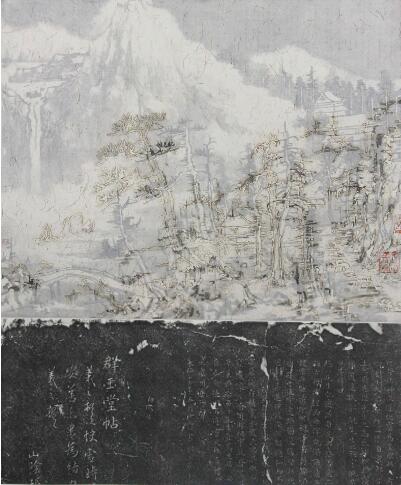
Wang Tiande, Hou Shan Revolve No. 16-MST 193; Rubbings, Xuan Paper, Ink and Burn Marks
NanHai Art is pleased to present Literati Gathering, an exhibition of new work by Wang Tiande, opening September 30, 2016 and on view through October 15, 2016.
Literati Gathering continues the artist’s “Houshan” series of layered, deconstructed compositional elements in response to the paintings and calligraphy of classical Chinese masters, here alighting Wu Hufan (1894-1968), the 20th century Chinese landscape master and renowned connoisseur, influenced by the Wu branch of the Southern School of Ming-era painters of his hometown Suzhou. These painters were often referred to as “literati” for their scholarly pursuit of painting as a vehicle for personal expression.Works in Wang’s “Houshan” series are comprised of two layers, one negative and one positive. On the under layer of xuan paper, landscapes and inscriptions are rendered in traditional Yuan and Ming painting compositions and brushwork. The upper surface of paper is burned through with incense sticks to create another landscape in negative space. These layers overlap but are intentionally mismatched, with the lower layer only vaguely visible through the upper, except in the burned-out voids, ultimately creating an illusion of spatial depth.
The appropriation of Yuan and Ming compositions are not complete, but ambiguous and disassembled, allowing for only the tenor and formal technical language of the ancient masters to be sensed through the semi-transparent surface layer. In this upper layer, the original ink strokes of the landscape and inscription have completely disappeared, along with the ashes of burning incense. This binary system approximates the modern anxiety of reconciling one’s past with the present. Having dislocated the clear delineation of time, a third space is now opened, in which a communion with the past may be achieved—a virtual dialogue between the ancient and modern.
“For some things, full display is unnecessary,” Wang says. “The value system of traditional landscape painting is obvious. We need not deny it. It exists. But our lifestyle and artistic discourse must be contemporary. These two layers, put together, will produce a new aesthetic experience.”
Wang’s interest in Wu Hufan is rooted in the latter’s reputation as both a staunch defender of Chinese traditional art practice, and a man of the modern world. Wu Hufan was born into an elite Suzhou family, and studied painting with the renowned Suzhou master Gu Lingshi. Later, he developed his own style, based on the study of his family’s rich collection of classical paintings and calligraphy. Thanks to the generous loan from the Linjin Collection, Literati Gathering will include two of Wu’s paintings: “Pine Landscape,” a work in the style of the literati painter Cao Zhibo (1272-1355) which synthesizes Yuan literati landscape with Tang and Song blue-green style and Ming Wu school brushwork; and “Autumn Mountains,” a reconstruction of a recorded painting by the Yuan master Huang Gongwang (1269-1354) combining the restrained brushwork of Yuan literati painting with the dramatic compositions popular in the 1930s landscape revival. By the artistic dialogue with Wu Hufan, and through the dislocation of time and space, Wang engages the full continuum of Chinese art, and put his audience in a double discourse of history and the present, thus a unique “literati gathering” may commence.
About the artistBorn in Shanghai in 1960, Wang Tiande graduated from the Chinese Paintings Department of Zhejiang Academy of Fine Arts (now China Academy of Art) in 1988 and later on obtained his doctorate degree from its Calligraphy Department. He is now a professor of art at Fudan University in Shanghai.
Wang Tiande has been continuously exploring the language of ink and its potential for spiritual expression. His work often takes its source in classical landscapes and calligraphy, but replacing the brushes with sticks of burning incense, and executing his images in a unique artistic language. He creates an expansive virtual space in which contemporary people can engage in dialogue and interchanges with both nature and the ancients, imbuing the landscape with a certain contemporaneity.
Wang Tiande’s works are in the collections of the National Art Museum of China, Shanghai Art Museum, Suzhou Museum, Shenzhen Art Museum, Guangdong Art Museum, Hong Kong Museum of Art, Museum of Fine Arts Boston, the Metropolitan Museum of Art, Spencer Museum of Art, the British Museum, the Montreal Museum of Fine Arts, and UC Berkeley Art Museum and Pacific Film Archive, as well as major private collections in Asia and the West.
About NanHai ArtFounded in San Francisco in 1986, NanHai Art is located in Millbrae, California, providing easy access for the Greater Bay Area art community. NanHai Art focuses on introducing major artworks by contemporary Chinese artists that reflect the unique aesthetics of Chinese art while transcending cultural and artistic boundaries with a contemporary sensibility.
About the exhibition
Exhibition Dates: September 30, 2016 - October 15, 2016
Opening Reception: September 30, 2016 5:30-6:30pm
Courtesy of the artist and NanHai Art, for further informaton please visit www.nanhaiart.com.




























